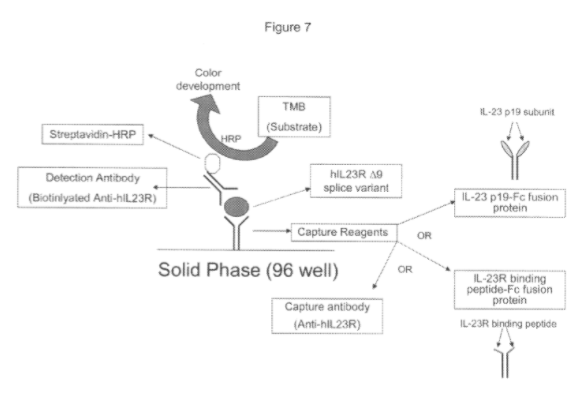Interleukin-23 (IL-23)
Interleukins are cytokines that act as immunomodulatory agents and are implicated in a variety of autoimmune inflammatory diseases. Interleukin-23 (IL-23), considered to be involved in the differentiation of T helper type 17 cells, is a principal molecule in autoimmunity and is an important drug target molecule for the treatment of many auto immune-inflammatory diseases.
Interleukin-23 receptor (IL-23R)
IL-23 binds to IL-23 receptors (IL-23R) thus triggering a cascade of signaling events that culminate in activating the target genes. IL-23 receptors expressed on T cells, natural killer cells, monocytes, and dendritic cells are made up of α subunits and β1 subunits.
The wild type mRNA
of IL-23 receptor α subunit (IL-23Rα) in humans is 2.8 kb long with 11 exons. IL-23Rα gene undergoes considerable alternative splicing to produce many different potential transcripts and translation products.
As can be seen from the following figure, the wild type IL-23Rα is a transmembrane protein having 629 amino acids, the protein comprising an extracellular domain (1-353 aa), transmembrane domain (354-376 aa), and a cytoplasmic domain (377-629 aa). The N-terminus of the extracellular domain has a signal peptide (1-23 aa) and a fibronectin-III-like domain. The cytoplasmic domain has three potential tyrosine phosphorylation sites.
One of the alternative splice form Δ 9 of IL-23Rα without exon 9 has only 348 aa and lacks the transmembrane domain and the cytoplasmic domain that is found in the wild type IL-23Rα. The Δ9 mRNA represents almost 20% of IL-23Rα transcripts in human leucocytes and is a major form of IL-23Rα mRNA.
Another alternative splice form Δ 8, 9 of IL-23Rα without exons 8 and 9 has only 318 aa and also lacks the transmembrane and the cytoplasmic domains. During alternative splicing in Δ 9 and Δ 8, 9 variants, there is a shift of open reading frames that results in premature termination, and a unique 8 amino acid sequence GLKEGSYC is formed at the C-terminus. Both Δ 9 and Δ 8, 9 variants of IL-23Rα are believed to be secreted proteins.

A US patent 9,523,073 granted on Dec 20, 2016, has claimed methods for serological detection of naturally-occurring soluble truncated variants of α subunit of IL-23 receptor for diagnosing autoimmune diseases including Crohn’s disease.
Specifically, an ELISA assay was developed and standardized for quantifying the Δ 9 variant of IL-23Rα in plasma samples and its level was found to correlate with the presence of inflammatory bowel diseases such as Crohn’s disease. It is to be mentioned that the Δ 9 variant of IL-23Rα was discovered by the inventors of the above-identified patent document.
As seen in the figure given below, a sandwich ELISA system was disclosed for detecting and quantifying the Δ 9 variant of IL-23Rα present in biological samples. The sample, preferably EDTA treated plasma, was incubated in a 96 well microtiter plate coated with capture reagents, preferably at about 40C for about 3 hours at a pH of about 9.5. The capture reagents could be antibodies against human IL-23R, IL-23R binding peptide-Fc fusion protein, or IL-23 p19 subunit-Fc fusion protein.
Detection antibodies that recognize a distinct epitope from the capture antibodies were then added to the system. In a particular embodiment, biotinylated antibodies for human IL-23R were used as detection antibodies that were tagged with Streptavidin conjugated with an enzyme reporter. A suitable substrate for the enzyme reporter was subsequently added and then the color intensity was measured for detection and quantification of the Δ 9 variant of IL-23Rα to diagnose Crohn’s disease.

The capture reagents are preferably monoclonal antibodies while the detection antibodies are preferably polyclonal antibodies. Preferably the capture antibodies bind to the C-terminus at or near exon 8 and the detection antibodies bind to the extracellular domain of the Δ 9 variant.
Other than Crohn’s disease, this system might be useful for diagnosing ulcerative colitis, asthma, and other autoimmune inflammatory diseases characterized by increased T helper type 17 cell activity.
ELISA plate image is taken from here.

Do check our recent blog post – https://prometheusip.com/patents/filing-of-application-for-a-patent-indian-patent-office/
Write to us at – https://www.linkedin.com/company/prometheus-patent-services-pvt-ltd
